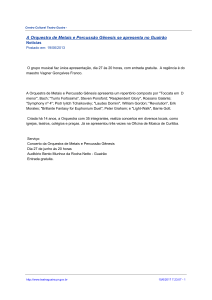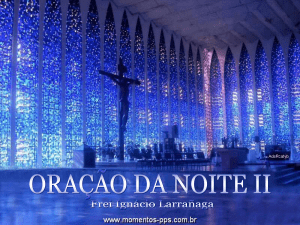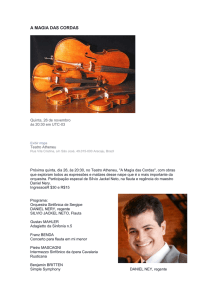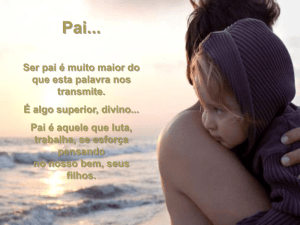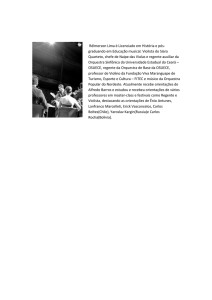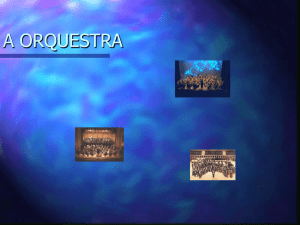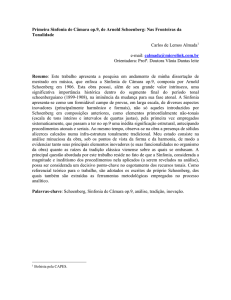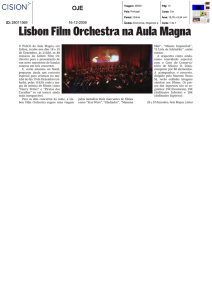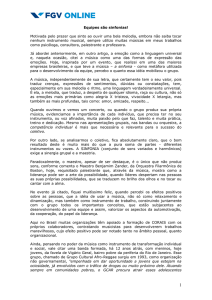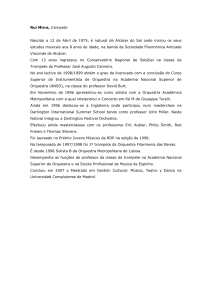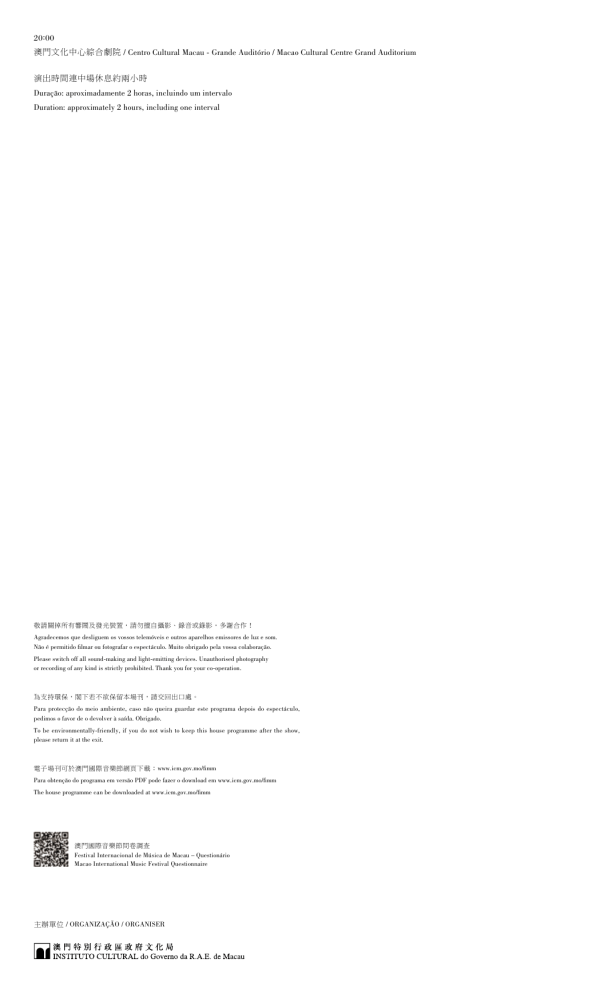
20 : 00
澳門文化中心綜合劇院 / Centro Cultural Macau - Grande Auditório / Macao Cultural Centre Grand Auditorium
演出時間連中場休息約兩小時
Duração: aproximadamente 2 horas, incluindo um intervalo
Duration: approximately 2 hours, including one interval
敬請關掉所有響鬧及發光裝置,請勿擅自攝影、錄音或錄影。多謝合作!
Agradecemos que desliguem os vossos telemóveis e outros aparelhos emissores de luz e som.
Não é permitido filmar ou fotografar o espectáculo. Muito obrigado pela vossa colaboração.
Please switch off all sound-making and light-emitting devices. Unauthorised photography
or recording of any kind is strictly prohibited. Thank you for your co-operation.
為支持環保,閣下若不欲保留本場刊,請交回出口處。
Para protecção do meio ambiente, caso não queira guardar este programa depois do espectáculo,
pedimos o favor de o devolver à saída. Obrigado.
To be environmentally-friendly, if you do not wish to keep this house programme after the show,
please return it at the exit.
電子場刊可於澳門國際音樂節網頁下載:www.icm.gov.mo/fimm
Para obtenção do programa em versão PDF pode fazer o download em www.icm.gov.mo/fimm
The house programme can be downloaded at www.icm.gov.mo/fimm
澳門國際音樂節問卷調查
Festival Internacional de Música de Macau – Questionário
Macao International Music Festival Questionnaire
主辦單位 / ORGANIZAÇÃO / ORGANISER
經 典 俄 羅 斯
D a Rússi a , c o m C lá s s ic o s
F r om Russi a , w ith C la s s ic s
馬 林 斯 基 劇 院 樂 團 ( 俄 羅 斯 )
Orq u e s tra d o Teatr o Mar iins ky (R ús s ia)
M a r iin s k y T h e atr e Or ches tr a (R us s ia)
2 2 / 10
© V. Baranovsky
經 典 俄 羅 斯
馬 林 斯 基 劇 院 樂 團 ( 俄 羅 斯 )
維那利.捷傑耶夫
指揮
馬林斯基劇院樂團
曲目
普羅科菲耶夫( 1891– 1953)
D大調第一交響曲 作品 25 “古典”
I. 快板
II. 間奏曲:小廣板
III. 嘉禾舞曲:不太快的快板
IV. 終曲:相當活潑
《羅密歐與茱麗葉》選段
第一管弦樂組曲 作品 64 bis
V. 面具
VII. 提伯爾特之死
第二管弦樂組曲 作品 64 ter
I. 蒙太古與凱普萊特家族 III. 勞倫斯神父 VII. 茱麗葉墓前的羅密歐
中場休息
降 B大調第五交響曲 作品 100
I. 行板
II. 清晰的快板
III. 慢板
IV. 滑稽的快板
曲目介紹
普羅科菲耶夫是二十世紀蘇俄樂壇的領軍人物
之一,其音樂作品數量巨大、體裁眾多、題材廣泛,
涉及交響曲、協奏曲、歌劇、芭蕾舞劇、鋼琴獨奏作
品、合唱、電影配樂、室內樂等領域。音樂語言雖不
算先鋒激進,但具有鮮明的藝術個性。
普羅科菲耶夫一生總共寫有七部交響曲,這一
體裁的創作貫穿其整個藝術生涯,也體現了作曲家音
樂風格和創作心境的變化,本場音樂會上演的兩部交
響曲在其中佔據著重要且特殊的地位。《 D 大調第一
交響曲》是一位生活在二十世紀的東歐作曲家用現代
的音樂語言和審美觀念重新詮釋輝煌的德奧古典傳
統。此曲寫於 1916 – 1917 年,在 1918 年作曲家遠赴美
國之前由他親自指揮並首演於彼得格勒。普羅科菲耶
夫在此曲中有意借用古典主義的音樂風格,並將之命
名為《古典》,認為這是“如果海頓生活在二十世紀
也會寫的那種交響曲”。頗具意味的是,在整個西方
音樂的歷史上,普羅科菲耶夫恰恰是海頓之後最偉大
的“幽默大師”,在用音樂表現“風趣”、“機智”
的方面,無出其右。此曲也常被看作是二十世紀初期
新古典主義風格的最早作品之一。樂曲採用古典時期
慣用的雙管制樂隊,織體清晰,音響清新明亮,與此
和史詩性氣魄。具有諧謔曲性質的第二樂章展現了作
同時運用了豐富多變的現代和聲語彙。全曲依照古典
曲家標誌性的幽默、諷刺、乖戾、怪誕,作曲家通過
交響曲的傳統四樂章模式佈局而成,規模較小,總體
配器、節奏等方面的多種變化讓古靈精怪的主要主題
結構精煉緊湊。富於普羅科菲耶夫特有的風趣詼諧口
經歷了一系列妙趣橫生的形象變換。對比性的中段既
吻。其中短小凝練的第三樂章採用了巴洛克時期常
有清新的田園氣息,也勾勒出迷人的舞蹈場面。第三
見的法國嘉禾舞曲,更為作品平添幾分古色古香的意
樂章是他抒情的典範篇章,將作曲家的旋律才華發揮
味。
得淋漓盡致。第四樂章始於一段慢速引子,大提琴和
《降 B 大調第五交響曲》的問世距離第一部已過
低音提琴吟唱出首樂章的第一主題。隨後生動詼諧的
去近三十年,此時作曲家的藝術與人生、世界的面貌
主要主題橫空出世,將音樂徹底從之前長時間的深沉
與局勢都發生了不小的變化。經歷了早年在美國和巴
抒懷切換回活力無限、亢奮不已的運動軌道,直至結
黎的旅居生涯之後,普羅科菲耶夫最終在三十年代中
尾處達到幾近瘋狂的最高潮。
期回到祖國,其風格語彙也從早期一定程度的先鋒氣
芭蕾舞劇音樂《羅密歐與茱麗葉》亦是普羅科菲
息變得更加質樸抒情,更加重視旋律的地位,但也依
耶 夫 回 國 後 的 作 品 , 寫 於 1935 年 , 後 來 作 曲 家 將 之
然保持著潑辣犀利、強壯剛健、富有動力的性格特
改編為三套管弦樂組曲和一部鋼琴獨奏套曲,取材於
質。《第五交響曲》寫於 1944年蘇聯衛國戰爭前夕,
膾炙人口的莎士比亞名著。音樂以精簡的材料塑造了
次年首演於莫斯科音樂學院音樂廳,由作曲家本人擔
諸多生動鮮明的人物形象,營造出引人入勝的戲劇氛
任指揮。樂曲具有鮮明的時代性和深刻的思想內涵,
圍,表達了真摯強烈的內心情感,長期以來一直是作
是對人類偉大力量和高尚情操的頌歌,被普遍視為作
曲家最受歡迎的曲目之一。本場音樂會將呈獻前兩套
曲家最傑出的交響曲作品。第一樂章以從容的步履、
組曲中的部分具有代表性的樂章。
寬廣的氣息、恢弘的姿態顯示出堅定、偉岸的英雄性
文/劉丹霓
藝術家及團體簡介
© Marco Borggreve
維那利.捷傑耶夫,指揮
捷傑耶夫的藝術造詣在國際備受肯定和歡迎。他
是聖彼得堡表演藝術學院的指揮代表,亦是傳奇指揮
伊利亞.穆辛教授的學生。於列寧格勒音樂學院修讀
期間,已榮獲卡拉揚國際指揮大賽及莫斯科全蘇聯指
揮大賽獎項,並獲邀加入基羅夫歌劇院(即現時的馬
林斯基劇院),於三十五歲起擔任劇院歌劇團的藝術
總監,並自 1996年起,擔任劇院的藝術總監及劇場總
監。捷傑耶夫亦是慕尼黑愛樂樂團的首席指揮、柴可
夫斯基國際音樂比賽組織委員會的聯合主席及愛丁堡
國際藝術節的名譽主席。
在馬林斯基劇院,捷傑耶夫見證了大量世界級歌
手的崛起。在他的帶領下,劇院的歌劇、芭蕾舞劇及
交響樂曲目變得更為豐富及多元,涵蓋一系列十八至
二十世紀的經典作品以及當代作曲家的音樂。有賴於
他的努力,於被燒燬的馬林斯基劇院工作坊原址,在
2006年落成了擁有完美音響效果的音樂廳,大大增強
了歌劇團及樂團的曲目水平。此外,於 2013年五月,
馬林斯基二館開幕,除了其室內樂廳,新館更能容納
二千名觀眾,這意味著馬林斯基劇院今天成了無可比
擬的劇院及音樂場地。
捷傑耶夫曾與大都會歌劇院、維也納愛樂樂團、
紐約愛樂、鹿特丹愛樂樂團和斯卡拉劇院愛樂樂團合
作。亦曾榮獲多項大獎,包括俄羅斯聯邦勞動英雄榮
譽稱號及由俄羅斯、德國、意大利、法國、日本、荷
蘭及波蘭政府頒授的其他榮譽勳章。
馬林斯基劇院樂團
馬林斯基劇院樂團為俄羅斯最古老的樂團之一,
《鮑里斯.戈東諾夫》以及理查德.史特勞斯、雅那
其歷史可追溯至十八世紀早期成立的聖彼得堡皇家歌
切克、莫扎特、威爾第、白遼士、普契尼及多尼采蒂
劇院管弦樂團。多位傳奇音樂家均指揮過此樂團,肯
的作品;除此之外,樂團亦加了交響樂及其他管弦樂
定樂團的卓越水平,包括白遼士、華格納、畢羅、柴
作品。樂團曾演奏貝多芬、布拉姆斯、馬勒、柴可夫
可夫斯基、馬勒、尼基施、拉赫曼尼諾夫、門格爾貝
斯基、普羅科菲耶夫及蕭斯塔科維奇的每首交響樂,
格、克萊姆佩勒、沃爾特、克萊伯及荀伯克。蘇聯時
以及斯特拉文斯基、梅湘、杜蒂耶、亨策、謝德林、
期,樂團持續備受肯定,曾執棒之知名指揮家包括:
季先科、古拜杜琳娜、康切里、卡列特尼可夫及拉斯
弗拉基米爾.德拉尼什尼科夫、阿雷.帕佐夫斯基、
卡托夫等作曲家的大量作品。馬林斯基劇院音樂廳於
穆拉汶斯基、君士坦丁.西梅奧諾夫及尤里.捷米爾
2006年開幕,馬林斯基二館(建於歷史建築物旁的現
卡諾夫等。樂團曾首演多部鉅作:眾多柴可夫斯基之
代劇院)於 2013年落成,皆使樂團曲目更為豐富,發
歌劇及芭蕾舞劇、格林卡、穆索斯基及林姆斯基-高
展更進一步。
沙可夫之歌劇,以及蕭斯塔科維奇、哈恰圖良及阿薩
菲夫的芭蕾舞劇。
在捷傑耶夫執棒下,馬林斯基劇院樂團與世界各
地大型歌劇院及音樂廳合作,包括大都會歌劇院、甘
樂團自 1988年起由維那利.捷傑耶夫帶領,他的
迺迪表演藝術中心、卡內基大廳、皇家歌劇院(柯芬
上任使樂團的曲目大為增加,歌劇方面包括:四部曲
園)、費利切劇院、三藩市歌劇院、斯卡拉大劇院、
《尼伯龍根的指環》、以德語表演的《羅恩格林》及
新以色列歌劇院、夏特雷劇院、普蕾亞音樂廳、維也
華格納的所有其他歌劇作品、普羅科菲可夫及蕭斯塔
納音樂廳、阿姆斯特丹的皇家音樂廳以及薩爾斯堡音
科維奇的所有歌劇、林姆斯基-高沙可夫之的大部分
樂節和愛丁堡國際藝術節。
作品及柴可夫斯基的歌劇作品、穆索斯基兩個版本的
© V. Baranovsky
D a Rússi a , c om C lá s s ic o s
Orq u e s tra d o Te a tr o M a r iins ky (R ús s ia)
Valery Gergiev
Maestro
Orquestra do Teatro Mariinsky
PROGRAMA
S. Prokofiev (1891-1953)
Sinfonia n.º 1 em Ré Maior, “Clássica”, op. 25
I. Allegro
II. Intermezzo: Larghetto
III. Gavotte: Non troppo allegro
IV. Finale: Molto vivace
Excertos de Romeu e Julieta
Suite n.º 1 para Orquestra, op. 64 bis
V. Máscaras
VII. Morte de Teobaldo
Suite n.º 2 para Orquestra, op. 64 ter
I. Montecchios e Capuletos
III. Frei Lourenço
VII. Romeu no Túmulo de Julieta
Intervalo
Sinfonia n.º 5 em Si Bemol Maior, op. 100
I. Andante
II. Allegro marcato
III. Adagio
IV. Allegro giocoso
NOTAS AO PROGRAMA
O compositor e pianista russo Sergei Prokofiev,
um gesto estilístico directamente emprestado da época
nascido em 1891, continua a ser uma figura central
clássica de Haydn. Uma combinação efervescente de
que ajudou a traçar a trajectória da música do século
violinos, interagindo com o tema principal, e as linhas
XX. Com raízes no romantismo russo e possuindo um
de acompanhamento do fagote, captam uma sensação de
sentido inato de tradicionalismo (como um dos muitos
engenhosidade e de humor intimamente associada tanto
artistas que deixaram a sua terra natal após a Revolução
a Haydn como a Prokofiev.
Bolchevique de 1917, Prokofiev foi o único compositor
O lento segundo movimento apresenta uma melodia
a regressar décadas depois), Prokofiev abraçou a
flutuante e transparente interpretada pelos violinos.
rápida evolução do século com as suas características
Nunca demasiado sombrio ou demasiado lamurioso,
de destreza com a melodia e percepção perspicaz da
Prokofiev injecta um episódio central contrastante,
harmonia moderna.
repleto de notas curtas e debicadas antes de regressar
ao tema principal idílico e iluminado. O movimento
Sinfonia n.º 1 em Ré Maior, “Clássica”, op. 25
subsequente, caracteristicamente uma dança na tradição
Prokofiev concluiu a sua Sinfonia n.º 1 em 1917,
Clássica, é baseado numa dança francesa, a Gavota.
um ano tumultuoso assolado por escassez de alimentos,
As cordas superiores, com uma retoma de quatro notas,
turbulência política e convulsão militar na Rússia.
conduzem a orquestra para uma dança elegante e
Para o compositor de 26 anos, já bem conhecido pela
grandiosa. Eventualmente, os sopros assumem o tema
sua abordagem modernista, este ano provou ser o mais
elegante, acompanhados pelo dedilhar das cordas.
produtivo e inspirado. Muitos ficaram surpreendidos
Finalmente, o último movimento, um fogo
quando o jovem compositor divulgou oficialmente a
rápido, um barril de força pleno de energia, captura o
sua Sinfonia n.º 1, revelando uma sinfonia clássica
esplendor dos finais vivazes e exultantes das sinfonias
estruturada, inspirada em não menos do que no próprio
da época Clássica, com o toque especial de Prokofiev.
pai da sinfonia clássica, Joseph Haydn. Sendo um
Simultaneamente anguloso, sardónico e altamente
excelente e consumado pianista, Prokofiev explica o
virtuoso, Prokofiev utiliza padrões rítmicos do período
conceito da sua abordagem ao esquema de Haydn:
Clássico e elabora um turbilhão de notas que abraça o
Tenho andando a brincar com a ideia de escrever
alegre entusiasmo classicista e, durante todo esse tempo,
uma sinfonia completa sem o piano. Composta dessa
estimula o seu próprio entendimento progressivo do
forma, as cores orquestrais teriam que ser, necessariamente,
século XX em termos das modernas harmonia e forma.
mas claras e limpas. Assim, o plano de uma sinfonia
com origem no estilo de Haydn, uma vez que o resultado
Suite n.º 1 e 2 para Orquestra de Romeu e
dos meus estudos fez com que a técnica de Haydn se
Julieta, op. 64 (Excertos)
tenha tornado especialmente clara para mim e, com esse
Concluído em 1935, o bailado Romeu e Julieta
profundo conhecimento, foi mais fácil mergulhar na
enfrentou um início conturbado, uma vez que nem
perigosa torrente sem um piano. Pareceu-me que se Haydn
o Teatro Kirov de São Petersburgo (conhecido como
estivesse hoje vivo, e apesar de ser fiel ao seu próprio estilo,
o Mariinsky da era pós-Soviética), nem o Bolshoi
se teria apropriado de alguma coisa da modernidade.
de Moscovo honraram a sua promessa de estrear a
Quero agora compor uma sinfonia assim: uma sinfonia à
obra, considerando o bailado como “impraticável”.
maneira clássica.
Como resultado, as suites n.º 1 e n.º 2 do concerto –
Na verdade, a sinfonia de quatro movimentos de
contendo música do bailado completo extraída pelo
Prokofiev não segue a fórmula clássica de Haydn: dois
próprio compositor – foram apresentadas em concertos
movimentos de suporte a enquadrar dois episódios
anteriores à estreia oficial do bailado em 1938, na
intermédios, um lento, outro tipo de música de dança. O
antiga Checoslováquia. Dois anos mais tarde, o Kirov
primeiro movimento abre com um grandioso florescer,
apresentou o bailado de Prokofiev ao público soviético
que o recebeu com grande sucesso – uma partitura que
enquanto compunha a sua Sinfonia n.º 5, Prokofiev
captava a imaginação esfusiante de Shakespeare, as
relata:
caracterizações intrigantes e o drama palpável.
Vejo a 5.ª Sinfonia como o culminar de um longo
Máscaras, da Suite n.º 1, simultaneamente
período da minha vida criativa. Quis cantar as preces do
exuberante e espiritual, descreve a chegada não
ser humano livre e feliz: força, generosidade e pureza de
anunciada de Romeu com os seus amigos Montecchios
alma. Não posso dizer que escolhi este tema; ele nasceu
ao baile dos Capuletos. Em Morte de Teobaldo, Romeu,
em mim e teve que ter expressão própria.
inicialmente relutante em envolver Teobaldo numa luta,
Dirigindo a estreia mundial da sua sinfonia em
acaba por vingar a morte de Mercúrio, matando Teobaldo.
Janeiro de 1945, Prokofiev subiu ao palco enquanto
A música de Prokofiev, cheia de energia rodopiante e
os sons muito reais dos canhões, a celebrarem o fim
frenética, é bem a expressão da agonia e dor de Teobaldo
eminente da guerra, irromperam no exterior da sala
após quinze golpes persistentes. Enquanto o corpo
de concertos em Moscovo. O famoso pianista soviético
de Teobaldo cai, Prokofiev incute na cena, fatalidade
Sviatoslav Richter recorda:
iminente e prefiguração de mais tragédia futura.
A sua batuta foi levantada. Ele esperou, e apenas
Na Suite n.º 2, desarmonias dissonantes captam a
começou após os canhões terem parado. Houve algo de
contenda orgulhosa e arrogante entre as duas famílias
muito significativo nisto, algo simbólico. Foi como se
em conflito, Montecchios e os Capuletos. Uma passagem
todos nós – incluindo Prokofiev – tivéssemos atingido um
central contrastante, subtilmente colorida pela harpa,
qualquer género de ponto de retorno.
pelo triângulo e violas deslizantes, ilustrando a dança de
A Sinfonia n.º 5 abre com um tema lírico ambicioso,
Julieta com Páris, o pretendente escolhido para Julieta
que se desenvolve rapidamente sobre um ronco do
pelos seus pais. Frei Lourenço proporciona um interlúdio
acompanhamento do baixo que, em muito, prenuncia o
profundo e sentido. Em bailado completo, Frei Lourenço
conflito e a discórdia ameaçadora. O movimento conclui
espera por Romeu e Julieta para casar os jovens amantes.
com uma coda épica, imbuída de grandiloquência
Em Romeu no Túmulo de Julieta, o tema de amor do
grandiosa e triunfante. Segue um movimento rápido, do
bailado do jovem casal imediatamente identificável,
género de dança, captando uma excentricidade satírica
regressa sobrecarregado pela solenidade esmagadora e
associada a uma articulação mordaz e nervosismo
pela tragédia das circunstâncias.
inquietante. O terceiro movimento – a incontestável
e ssê n c i a e m o c i o n a l d a si n f o n i a d e P r o k o f i e v –
Sinfonia n.º 5 em Si Bemol Maior, op. 100
apresenta muito lirismo arrebatador e tragédia cinéfila,
A Sinfonia n.º 5 de Prokofiev, composta no Verão de
contrariamente à cena da morte de Julieta do compositor
1944, é a primeira sinfonia “Soviética” do compositor (a
de Romeu e Julieta. O final, abre com uma recapitulação
Sinfonia n.º 1 foi concluída antes da Revolução, a n.º 2
nostálgica do tema de abertura do primeiro movimento e
até n.º 4 foram compostas enquanto o compositor vivia no
lança-se numa série de episódios vigorosos ritmicamente
seu exílio auto imposto nos EUA e Europa). Depois de
conduzidos a um formato “pergunta e resposta”. Com
regressar à sua terra natal em 1936, Prokofiev fez prova
compassos suspensos e contra melodias exuberantes,
da sua capacidade em contornar as perseguições volúveis
o tema rítmico lúdico cresce ainda mais maníaco e
e inflamadas do sistema político soviético, em contraste
frenético com cada interacção até Prokofiev terminar
com muitos dos seus menos afortunados colegas.
tudo com um desabrochar obsessivo e implacável.
Enquanto o mundo estava envolvido na II Guerra
Mundial, Prokofiev estava a 150 milhas de Moscovo,
a viver num retiro reservado para os artistas mais
aclamados e importantes da União Soviética. Protegido
de grande parte da brutalidade imediata da guerra,
@ Jules Lai
NOTAS BIOGRÁFICAS
© Marco Borggreve
Valery Gergiev, Maestro
A arte de Valery Gergiev tem tido muita procura
do Teatro Mariinsky que tinham sido incendiados, o que
por todo o mundo. O maestro é um representante notável
ampliou significativamente as capacidades da companhia
da escola de São Petersburgo e um ex-aluno do lendário
e da orquestra. Em Maio de 2013, foi inaugurado o
professor Ilya Musin. Ainda estudante do Conservatório
Mariinsky II, um edifício com lotação para 2000 pessoas,
de Leningrado, Gergiev ganhou o prestigiado Concurso
o que significa que actualmente o Teatro Mariinsky não
de Direcção de Orquestras Herbert von Karajan, o
tem paralelo como teatro e sala de concertos.
Concurso de Direcção de Orquestras All-Union, em
Gergiev trabalha com a Opera Metropolitana, as
Moscovo, e foi convidado a integrar o Teatro Kirov
Orquestras Filarmónicas de Viena, Nova York e Roterdão e
(agora Mariinsky) onde, com 35 anos, foi nomeado
a Filarmónica della Scala. Os inúmeros prémios recebidos
director artístico da Companhia de Ópera. Desde 1996,
por Gergiev incluem Herói do Trabalho da Federação
é director geral e Artístico e do Teatro. Valery Gergiev é
Russa e outras prestigiadas condecorações da Rússia,
também o maestro principal da Filarmónica Münchner,
Alemanha, Itália, França, Japão, Holanda e Polónia.
co-presidente do Comité Organizativo do Concurso
Internacional Tchaikovsky e presidente honorário do
Festival Internacional de Edimburgo.
No Teatro Mariinsky, Gergiev tem supervisionado
o aparecimento de um grande número de cantores de
classe mundial. Sob sua direcção, os reportórios do teatro
para ópera, ballet e música sinfónica tornaram-se muito
mais ricos e diversificados, incluindo, agora, uma ampla
variedade de obras dos clássicos dos séculos XVIII a XX
e música de compositores contemporâneos. Graças aos
seus esforços, o acusticamente perfeito Concert Hall foi
construído em 2006 e inaugurado no local dos ateliers
Orquestra do Teatro Mariinsky
A Orquestra do Teatro Mariinsky é um dos mais
Rimsky-Korsakov e Tchaikovsky, ambas as versões de
antigos conjuntos musicais na Rússia. A sua história
Mussorgsky de Boris Godunov e as óperas de Richard
remonta ao início do século XVIII, data da fundação
Strauss, Janácek, Mozart, Verdi, Berlioz, Puccini e
da Ópera Imperial de S. Petersburgo. A excelência
Donizetti), o reportório da orquestra passou a incluir
da orquestra foi reconhecida em numerosas ocasiões
obras sinfónicas e outros géneros de música filarmónica.
por músicos de classe mundial que a dirigiram, entre
A orquestra tem tocado todas as sinfonias de
eles Berlioz, Wagner, von Bülow, Tchaikovsky, Mahler,
Beethoven, Brahms, Mahler, Tchaikovsky, Prokofiev
Nikisch, Rachmaninoff, Mengelberg, Klemperer, Walter,
e Shostakovich e várias obras de compositores como
Kleiber e Schoenberg.
Stravinsky, Messiaen, Dutilleux, Henze, Shtchedrin,
Nos tempos soviéticos, as ilustres tradições do
Tishchenko, Gubaidulina, Kancheli, Karetnikov e
conjunto foram continuadas por maestros como Vladimir
Raskatov, entre muitos outros. A inauguração da Sala de
Dranishnikov, Ariy Pazovsky, Yevgeny Mravinsky,
Concertos do Teatro Mariinsky em 2006 e da Mariinsky
Konstantin Simeonov e Yuri Temirkanov. A orquestra
II, um edifício moderno junto a um histórico, em 2013,
teve a honra de ser a primeira a tocar muitas óperas e
resultou no enriquecimento do reportório e em melhorias
bailados de Tchaikovsky, óperas de Glinka, Mussorgsky
na orquestra.
e Rimsky-Korsakov e bailados de Shostakovich,
Sob a batuta de Gergiev, o Teatro Mariinsky
Khachaturian e Asafiev. Desde 1988, a orquestra é
colabora com as principais casas de ópera e salas
dirigida por Valery Gergiev. Com a chegada de Gergiev,
de concerto em todo o mundo, incluindo a Opera
o reportório da orquestra tem sido significativamente
Metropolitana, o Centro Kennedy, Carnegie Hall, Royal
alargado. Além de óperas (em primeiro e mais importante
Opera House (Covent Garden), Teatro Carlo Felice,
a tetralogia Der Ring des Nibelungen, bem como, todas
Ópera de São Francisco, Teatro alla Scala, Opera New
as outras óperas de Wagner, começando com Lohengrin
Israeli, Théâtre du Châtelet, Sala Pleyel, Konzerthaus de
interpretada em alemão, todas as óperas de Prokofiev
Viena, Concertgebouw de Amesterdão e os Festivais de
e Shostakovich, grande parte do legado das óperas de
Salzburgo e Edimburgo.
© V. Baranovsky
Fr om Russi a , w ith Cla s s ic s
M a r iin s k y T h e a tre Or ches tr a (R us s ia)
Valery Gergiev
Conductor
Mariinsky Theatre Orchestra
PROGRAMME
S Prokofiev (1891-1953)
Symphony No. 1 in D Major, op. 25 (“Classical”)
I.
Allegro
II. Larghetto
III. Gavotte: Non troppo allegro
IV. Finale: Molto vivace
Excerpts from Romeo and Juliet
Suite No. 1 for Orchestra, op. 64 bis
V.
Masks
VII. Death of Tybalt
Suite No. 2 for Orchestra, op. 64 ter
I.
Montagues and Capulets
III. Friar Lauwrence
VII. Romeo at Juliet’s Grave
Interval
Symphony No. 5 in B-flat Major, op. 100
I.
Andante
II. Allegro marcato
III. Adagio
IV. Allegro giocoso
PROGRAMME NOTES
Russian composer and pianist Sergei Prokofiev,
Haydn’s Classical era. A sparkling blend of the violins,
born in 1891, remains a central figure who helped
iterating the main theme, and the accompanying bassoon
th
shape the trajectory of 20 century music. With roots
lines capture a sense of wit and humour so closely
in Russian Romanticism and possessing an innate
associated with both Haydn and Prokofiev.
sense of traditionalism (as one of many artists leaving
The slow second movement features a floating,
their homeland after the Bolshevik Revolution of 1917,
transparent melody played by the violins. Never
Prokofiev was the only composer to return decades later),
too somber or overtly lamenting, Prokofiev injects a
Prokofiev nevertheless embraced the rapidly-evolving
contrasting central episode filled with short, pecking
century with his characteristic knack for melody and
notes before returning to the idyllic, moonlit main theme.
keen sense of modern harmony.
The subsequent movement, characteristically a dance
in the Classical tradition, is based on a French dance
Symphony No. 1 in D Major, op. 25 (“Classical”)
form, the Gavotte. The upper strings, with a four-note
Prokofiev completed his Symphony No. 1 in 1917,
pick-up, leads the orchestra into a courtly and grand
a tumultuous year plagued with food shortages, political
dance. Winds eventually take over the elegant theme,
turmoil, and military upheaval in Russia. For the 26-year-
accompanied by plucked strings.
old composer, already well-known for his modernist
Finally, the last movement, a rapid-fire, tour de
approach, the turbulent year proved to be one of Prokofiev’s
force barrel of energy, captures the brilliance of a
most productive and inspired. In turn, many were surprised
Classical-era symphony’s vivacious and jubilant finale
when the young composer officially unveiled his Symphony
with the characteristic Prokofiev twist. At once angular,
No. 1, revealing a Classically-structured symphony
sardonic and highly virtuosic, Prokofiev utilises rhythmic
inspired by none other than the father of the Classical
patterns typical of the Classical period and devises a
symphony himself, Joseph Haydn. A fine and accomplished
whirlwind of notes that embraces Classicism’s joyful élan,
pianist, Prokofiev explains the conception of his Haydn-
all the while boasting his own 20th-century, progressive
esque approach:
understanding of modern harmony and design.
I had been playing with the idea of writing
a whole symphony without the piano. Composed
Suites Nos. 1 and 2 for Orchestra from Romeo
in such a fashion, the orchestral colours would, of
and Juliet, op. 64 (Excerpts)
necessity, be clearer and cleaner. Thus the plan of a
Completed in 1935, Prokofiev’s ballet Romeo and
symphony in the style of Haydn originated, since, as
Juliet endured a troubled beginning, as neither Kirov
a result of my studies, Haydn’s technique had become
Theatre in St. Petersburg (known as the Mariinsky in
especially clear to me, and with such thorough
post-Soviet era) nor Moscow’s Bolshoi kept its promise
understanding it was much easier to plunge into the
to present and premiere the work, deeming the ballet
dangerous flood without a piano. It seemed to me
as “undanceable”. As a result, the concert Suites No.
that, if he were alive today, Haydn, while retaining
1 and No. 2 – containing music from the full-length
his own style, would have appropriated something
ballet extracted by the composer himself – were in
from the modern. Such a symphony I now wanted to
fact performed in concerts prior to the ballet’s official
compose: a symphony in the Classic manner.
premiere in 1938 in the former Czechoslovakia. Two
Prokofiev’s four-movement symphony does
years later, the Kirov finally presented Prokofiev’s ballet
indeed follow Haydn’s Classical formula: two bookend
– a score encapsulating Shakespeare’s sparkling imagery,
movements framing two middle episodes, one slow,
intriguing characterisations, and palpable drama – to the
one dance-like. The first movement opens with a grand
Soviet audiences with great success and reception.
flourish, a stylistic gesture directly borrowed from
Masks from Suite No. 1, at once exuberant and
spirited, depicts the unannounced arrival of Romeo with
a person’s strength, generosity and purity of soul. I
his fellow Montagues at the Capulet’s ball. In Death of
cannot say I chose this theme; it was born in me and
Tybalt, Romeo, initially reluctant to engage Tybalt in a
had to express itself.
fight, avenges the death of Mercutio by killing Tybalt.
Conducting the world premiere of his symphony in
Prokofiev’s music, filled with swirling, frenetic energy,
January of 1945, Prokofiev stood on the podium as the
encapsulates Tybalt’s agony and pain with fifteen
very real sounds of cannons celebrating the imminent
persistent percussive blasts. As Tybalt’s body falls,
end to the war erupted outside the concert hall in
Prokofiev imbues the scene with impending doom and
Moscow. Renowned Soviet pianist Sviatoslav Richter
foreshadowing of even more tragedy to come.
recalls:
From Suite No. 2, jarring dissonances capture the
His baton was raised. He waited, and began only
conceited and haughty feud between the two warring
after the cannons had stopped. There was something
families in Montagues and Capulets. A contrasting
very significant in this, something symbolic. It was as
central passage, subtly coloured by harp, triangle, and
if all of us – including Prokofiev – had reached some
sliding violas, illustrate Juliet’s dance with Paris, the
kind of shared turning point.
suitor chosen for Juliet by her parents. Friar Laurence
Symphony No. 5 opens with an aspiring and
offers a lilting and heartfelt interlude; in the full ballet,
lyrical motif, soon soaring atop a growling basso
Friar Laurence is waiting for Romeo and Juliet in order
accompaniment that foreshadows much ominous discord
to marry the two young lovers. In Romeo at Juliet’s
and conflict. The movement concludes in an epic
Grave, the young couple’s immediately-identifiable
coda, imbued with grandeur and triumphant bombast.
love theme from the ballet returns, this time burdened
A fast, dance-like movement follows, capturing a
by the overwhelming solemnity and tragedy of their
satirically whimsy coupled with biting articulation
circumstance.
and unsettling edginess. The third movement – the
unmistakable emotional core of Prokofiev’s symphony
Symphony No. 5 in B-flat Major, op. 100
– offers much sweeping lyricism and cinematic tragedy
Prokofiev’s Symphony No. 5, composed in the
not unlike Juliet’s death scene from the composer’s
summer of 1944, is the composer’s first “Soviet” Symphony
Romeo and Juliet. The finale, opening with a nostalgic
(Symphony No. 1 was completed pre-Revolution, while
reexamination of the first movement’s opening theme,
Symphonies No. 2 through 4 were written while the
launches into a vigorous series of rhythmically-driving
composer lived in self-imposed exile in the United States
“question and answer” episodes. Interrupted time and
and Europe). After returning to his homeland in 1936,
again by lush counter-melodies, the playful rhythmic
Prokofiev proved his adeptness in circumventing the Soviet
motif grows more manic and frenetic with every
political system’s fickleness and flaring persecutions, at
iteration until Prokofiev finally ends it all with an
least in contrast to many of his less fortunate colleagues.
obsessive and unrelenting flourish.
While the world was embroiled in World War II,
Prokofiev was 150 miles away from Moscow, living in a
retreat reserved for the Soviet Union’s most acclaimed
and important artists. Sheltered from much of the war’s
immediate brutality as he composed his Symphony No. 5,
Prokofiev recounts:
I regard the Fifth Symphony as the culmination
of a long period my creative life. I wanted to sing the
praises of the free and happy human being – of such
@ Jules Lai
BIOGRAPHICAL NOTES
© Marco Borggreve
Valery Gergiev, Conductor
The art of Valery Gergiev is in great demand
repertoire abilities of the company and the orchestra,
throughout the world. The maestro is a remarkable
while in May 2013, there came the opening of the
representative of the St. Petersburg performing
Mariinsky-II – a new building that seats 2000 people in
school and a former pupil of the legendary Professor
addition to its chamber venues, meaning that today the
Ilya Musin. While still a student at the Leningrad
Mariinsky Theatre stands unparalleled as a theatre and
Conservatoire, Gergiev won the incredibly prestigious
concert venue.
Herbert von Karajan Conducting Competition as well
Gergiev works with the Metropolitan Opera,
as the All-Union Conducting Competition in Moscow
the Vienna, New York and Rotterdam Philharmonic
and was invited to join the Kirov (now the Mariinsky)
Orchestras and the Filarmonica della Scala. Gergiev’s
Theatre, where at the age of 35 he was appointed Artistic
numerous awards and prizes include Hero of Labour of
Director of the Opera Company, while since 1996 he has
the Russian Federation and other prestigious government
been Artistic and General Director of the theatre. Valery
decorations from Russia, Germany, Italy, France, Japan,
Gergiev is also the Principal Conductor of the Münchner
The Netherlands and Poland.
Philharmoniker, Co-Chairman of the Organisational
Committee of the International Tchaikovsky Competition
and Honorary President of the Edinburgh International
Festival.
At the Mariinsky Theatre, Gergiev has overseen
the emergence of a plethora of world-class singers.
Under his direction, the Theatre’s opera, ballet and
symphony music repertoires have become much richer
and more diverse, now including a broad range of works
from the 18th to 20th century classics as well as music
by contemporary composers. Thanks to his efforts, the
acoustically perfect Concert Hall was built in 2006
and opened on the site of Mariinsky Theatre workshops
that had burnt down, which significantly enlarged the
Mariinsky Theatre Orchestra
The Mariinsky Theatre Orchestra is one of the
of Musorgsky’s versions of Boris Godunov and operas
oldest musical ensembles in Russia. Its history dates
by Richard Strauss, Janácek, Mozart, Verdi, Berlioz,
back to the St. Peterburg Imperial Opera Orchestra
Puccini and Donizetti), the Orchestra’s repertoire has
th
founded in the early 18 century. The excellence of
come to include symphonic works and other genres of
the orchestra was recognised on numerous occasions
philharmonic music. It has performed every symphony
by the world-class musicians who conducted it, among
by Beethoven, Brahms, Mahler, Tchaikovsky, Prokofiev
them Berlioz, Wagner, von Bülow, Tchaikovsky, Mahler,
and Shostakovich and various works by composers such
Nikisch, Rachmaninoff, Mengelberg, Klemperer, Walter,
as Stravinsky, Messiaen, Dutilleux, Henze, Shchedrin,
Kleiber and Schoenberg. In Soviet times, the ensemble’s
Tishchenko, Gubaidulina, Kancheli, Karetnikov and
illustrious traditions were continued by such conductors
Raskatov, among many others. The opening of the
as Vladimir Dranishnikov, Ariy Pazovsky, Yevgeny
Concert Hall of the Mariinsky Theatre in 2006 and
Mravinsky, Konstantin Simeonov and Yuri Temirkanov.
Mariinsky-II, a new modern theatre building alongside
The orchestra has had the honour of being the first to
the historical one, in 2013, has resulted in an enriched
perform many operas and ballets by Tchaikovsky, operas
repertoire and improvements of the Orchestra.
by Glinka, Musorgsky and Rimsky-Korsakov and ballets
by Shostakovich, Khachaturian and Asafiev.
Under Gergiev’s baton, the Mariinsky Theatre
Orchestra collaborates with major opera houses and
Since 1988, the Orchestra has been directed by
concert venues throughout the world, including the
Valery Gergiev. With Gergiev’s arrival, the Orchestra’s
Metropolitan Opera, the Kennedy Center for the
repertoire has expanded significantly. In addition to
Performing Arts, Carnegie Hall, the Royal Opera House
operas (first and foremost the tetralogy Der Ring des
(Covent Garden), the Teatro Carlo Felice, the San
Nibelungen as well as all of Wagner’s other operas
Francisco Opera, the Teatro alla Scala, the New Israeli
starting with Lohengrin performed in German, all of
Opera, the Théâtre du Châtelet, the Salle Pleyel, the
Prokofiev and Shostakovich’s operas, the lion’s share of
Wiener Konzerthaus, Amsterdam’s Concertgebouw and
Rimsky-Korsakov and Tchaikovsky’s opera legacy, both
the Salzburg and Edinburgh Festivals.
馬林斯基劇院樂團
Orquestra do Teatro Mariisky
Mariinsky Theatre Orchestra
指揮 / Maestro / Conductor
維那利.捷傑耶夫 Valery Gergiev
第一小提琴 / Primeiros Violinos / First Violins
Alexei Lukirsky
Olga Volkova
Leonid Veksler
Anton Kozmin
Mikhail Rikhter
Khristian Artamonov
Dina Zikeyeva
Kristina Minosian
Viktoria Boezhova
Danara Urgadulova
Anna Glukhova
Tatiana Moroz
Kirill Murashko
Elizaveta Semagina
第二小提琴 / Segundos Violinos / Second Violins
Zumrad Ilieva
Maria Safarova
Elena Luferova
Natalia Polevaya
Inna Demchenko
Andrei Novodran
Dmitry Neklyudov
Natalia Izak
Viacheslav Grikurov
Olga Timofeeva
中提琴 / Violas
Yuri Afonkin
Lina Golovina
Alexander Shelkovnikov
Yevgeny Barsov
Roman Ivanov
Mikhail Anikeyev
Andrei Petushkov
Alevtina Alexeyeva
Andrei Lyzo
Liudmila Ketova
大提琴 / Violoncelos / Cellos
Oleg Sendetsky
Anton Gakkel
Dmitry Ganenko
Viktor Kustov
Yekaterina Larina
Vladimir Yunovich
Oxana Moroz
Ekaterina Lebedeva
低音提琴 / Contrabaixos / Double Basses
Vladimir Shostak
Dmitry Popov
Yevgeny Ryzhkov
Boris Markelov
Sergei Trafimovich
Demiyan Gorodnichin
長笛 / Flautas / Flutes
Nikolai Mokhov
Denis Lupachev
Tatiana Khvatova
Mikhail Pobedinskiy
雙簧管 / Oboés / Oboes
Alexander Levin
Alexei Fyodorov
Viktor Ukhalin
Ilya Ilin
單簧管 / Clarinetes / Clarinets
Viktor Kulyk
Ivan Stolbov
Nikita Vaganov
Dmitry Kharitonov
Vitaly Papyrin
巴松管 / Fagotes / Bassoons
Rodion Tolmachev
Yuri Radzevich
Ruslan Mamedov
圓號 / Trompas / Horns
Dmitry Vorontsov
Alexander Afanasiev
Vladislav Kuznetsov
Yuri Akimkin
Pyotr Rodin
小號 / Trompetes / Trumpets
Timur Martynov
Yuri Fokin
Vitaly Zaitsev
Nikita Istomin
長號 / Trombones
Alexei Lobikov
Alexander Gorbunov
Alexander Dzhurri
Vladimir Polevin
豎琴 / Harpas / Harps
Sofia Kiprskaya
Elena Klass
鍵盤音樂 / Teclado / Keyboard
Olga Okhromenko
樂團經理 / Gerente da Orquestra / Orchestra Manager
Vladimir Ivanov
巡演經理 / Coordenação da Digressão / Tour Manager
Nadya Bitskaya
舞臺工作人員 / Técnicos de Palco / Stage Hands
Dmitry Popov
Pavel Popov
馬林斯基劇院行政管理 ( 澳門) /
Dinecção Executiva do Teatro Mariinksy em Macau /
Executive Management of Mariinsky Theatre in Macao
總監 / Directora / Director
Olivia Ma @ Olivia Ma Artists Management
大號 / Tuba
Nikolai Slepnev
敲擊樂 / Percussão / Percussion
Andrei Khotin
Arseny Shuplyakov
Yury Alexeyev
Yevgeny Zhikalov
Vladislav Ivanov
Dmitry Fedorov
Global Partners:
主辦單位人員
市場推廣協調 / Assistente de
宋健文 Song Kin Man
FICHA TÉCNICA
PERSONNEL
Coordenação de Marketing /
Marketing Assistant Coordinator
彭 穎 Pang Weng
安東尼 António Lucindo
總監 / Directores / Directors
戚國林 Chek Kuok Lam
攝影 / Fotografia / Photography
吳衛鳴 Ung Vai Meng
巿場推廣執行 / Marketing
林壽華 Lam Sao Wa
梁曉鳴 Leung Hio Ming
林思恩 Lam Si Ian
秦振華 Chon Chan Wa
許文輝 Hoi Man Fai
節目及外展活動統籌 / Coordenador
黃武星 Wong Mou Seng
de Programação e Actividades
de Extensão / Programming and
Outreach Activities Coordinator
蕭婉屏 Sio Un Peng
楊子健 Ieong Chi Kin
文宣翻譯 / Tradução de Materiais
Promocionais / Translation of
Promotional Materials
雷凱爾 Michel Reis
林玲玲 Lam Leng Leng
唐麗明 Tong Lai Meng
節目協調 / Assistentes de
Coordenação de Programação /
Programming Assistant Coordinators
李碧琪 Paula Lei
岑婉清 Sam Un Cheng
葉展鵬 Ip Chin Pang
節目執行 / Programação /
Programming Executive
吳思衍 Ung Si In
何影儀 Ho Ieng I
Coordenação do Programa de
Extensão / Outreach Activities
Assistant Coordinators
羅德慧 Lo Tak Wai
陳淑芬 Chan Sok Fan
外展活動執行 / Programa de
Extensão / Outreach Activities
Executives
彭錦濤 Pang Kam Tou
何詠賢 Ho Weng In
陳頴藍 Willa Chan
張彥君 Cheong In Kuan
吳婷恩 Ng Teng Ian
張倩儀 Cheong Sin I
技術統籌 / Coordenação Técnica /
Technical Coordination
演藝活動處
Divisão de Actividades das Artes
do Espectáculo
市場推廣、傳媒關係及客戶服務
統籌 / Coordenação de Marketing,
Relações com a Imprensa e Serviço
ao Cliente / Marketing, Media
Relations & Customer Service
Coordinator
林俊強 Lam Chon Keong
場刊翻譯 / Tradução dos Programas
de Casa / Translation of House
Programme
新域顧問有限公司
傳媒關係協調 / Assistente de
Vectormais Consultores
Relações com a Imprensa / Media
Relations Assistant Coordinator
郭妙瑜 Kuok Mio U
奕文軒語言服務有限公司
傳媒關係執行 / Assessoria de
外展活動協調 / Assistentes de
場刊協調及編輯 / Coordenação
e Edição dos Programas de Casa /
House Programmes Coordinators and
Editors
呂莉莉 Loi Lei Lei
林潔婷 Lam Kit Teng
Imprensa / Media Relations
Executives
區倩茹 Ao Sin U
梁靜儀 Leong Cheng I
客戶服務協調 / Assistente de
Coordenação do Serviço ao
Cliente / Customer Service
Assistant Coordinator
鄧少儀 Tang Sio I
客戶服務執行 / Serviço ao Cliente /
Customer Service
翁麗晶 Yung Lai Jing
吳曉彤 Ng Hio Tong
李振文 Lei Chan Man
黃武星 Wong Mou Seng
方君玲 Fong Kuan Leng
梁善因 Leung Sin Ian
袁嘉麗 Un Ka Lai
吳珮瑤 Ng Pui Io
影視製作 / Produção de Vídeo /
Video Production
梁劍星 Leung Kim Sing
Poema Language Services
校對 / Revisão / Proofreading
林潔婷 Lam Kit Teng
Filipa Galvão
設計主任 / Direcção Gráfica /
Art Director
黃惠明 Vong Vai Meng
設計 / Design
黃 鎮 Wong Chan
吳曉偉 Ng Hio Wai
陳穎琳 Chan Weng Lam
印刷 / Impressão / Printed by
華輝印刷有限公司
Welfare Printing Ltd.

